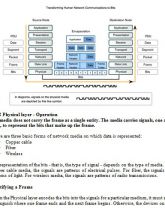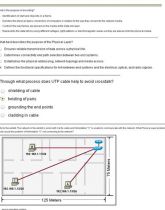Poznámky: Cisco4 (kapitola 8)
Skryť detaily | Obľúbený- Kvalita:83,5 %
- Typ:Poznámky
- Univerzita:Technická univerzita v Košiciach
- Fakulta:Fakulta elektrotechniky a informatiky
- Kategória:Technika
- Podkategória:Informatika
- Predmet:Počítačové siete
- Autor:weissquin
- Ročník:2. ročník
- Rozsah A4:50 strán
- Zobrazené:2 226 x
- Stiahnuté:2 x
- Veľkosť:7,6 MB
- Formát a prípona:Archív súborov (.zip)
- Jazyk:anglický
- ID projektu:4450
- Posledna úprava:03.09.2017
Upper OSI layer protocols prepare data from the human network for transmission to its destination. The Physical layer controls how data is placed on the communication media.
The role of the OSI Physical layer is to encode the binary digits that represent Data Link layer frames into signals and to transmit and receive these signals across the physical media - copper wires, optical fiber, and wireless - that connect network devices.
This chapter introduces the general functions of the Physical layer as well as the standards and protocols that manage the transmission of data across local media.
In this chapter, you will learn to:
• Explain the role of Physical layer protocols and services in supporting communication across data networks.
• Describe the purpose of Physical layer signaling and encoding as they are used in networks.
• Describe the role of signals used to represent bits as a frame is transported across the local media.
• Identify the basic characteristics of copper, fiber, and wireless network media.
• Describe common uses of copper, fiber, and wireless network media.
The role of the OSI Physical layer is to encode the binary digits that represent Data Link layer frames into signals and to transmit and receive these signals across the physical media - copper wires, optical fiber, and wireless - that connect network devices.
This chapter introduces the general functions of the Physical layer as well as the standards and protocols that manage the transmission of data across local media.
In this chapter, you will learn to:
• Explain the role of Physical layer protocols and services in supporting communication across data networks.
• Describe the purpose of Physical layer signaling and encoding as they are used in networks.
• Describe the role of signals used to represent bits as a frame is transported across the local media.
• Identify the basic characteristics of copper, fiber, and wireless network media.
• Describe common uses of copper, fiber, and wireless network media.




